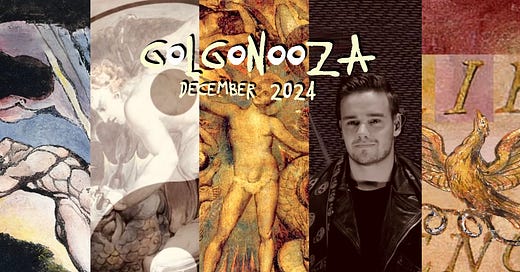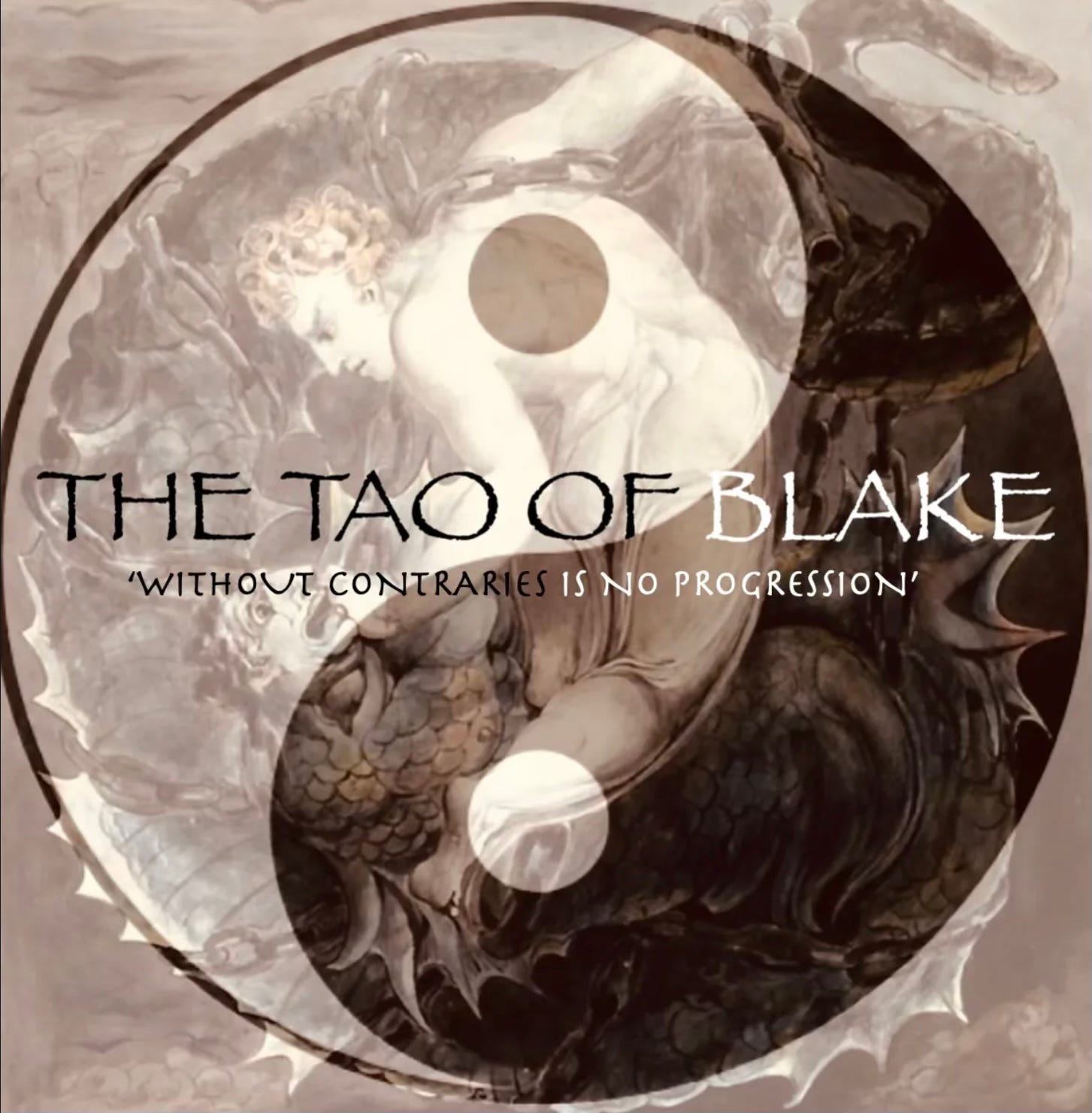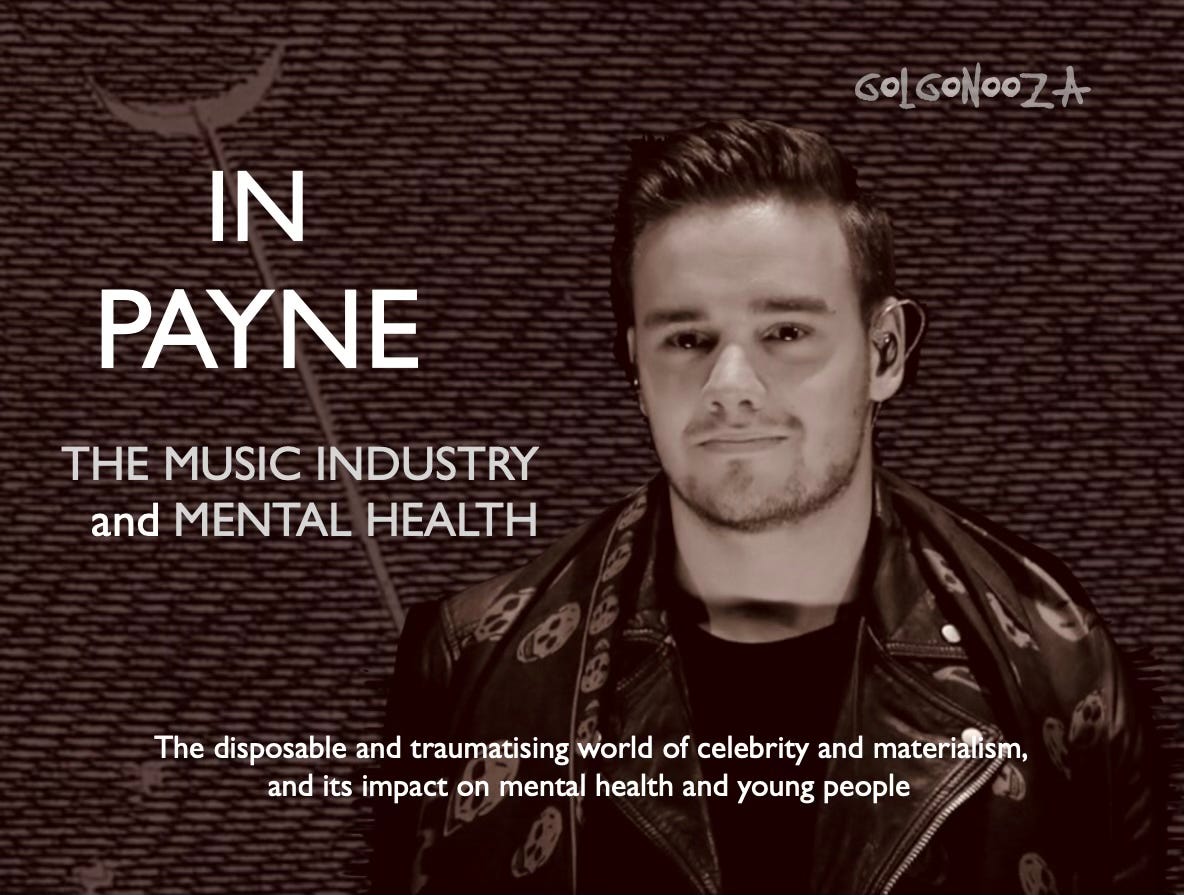Dear Golgonoozans!
Welcome to the first Golgonooza newsletter! - a monthly round-up of what’s been happening the world of Blake, a quick look at the posts of the last few weeks, and a preview of what’s coming up on this Golgonooza Substack site in the next couple of months as we head into 2025 and a brave new year …
The start of November saw the launch of this new Golgonooza Substack site (launched at 11.11am on 1.11 for those interested in such things! - it’s called ‘binary arithmetic’ Alan Watts says: from I and 0 you can generate all possible numbers, and it’s the basis of digital computers … such as Substack! So I thought it’d be fun to have the four 1s go with the four 0s in the word ‘Golgonooza’ - which as the eagle-eyed may have noticed are differentiated in white in the word to make them stand out! Zeros and noughts are always kind of cool I think. Also, often when I look at the time it’s ‘11.11’ - does anyone else get that?).
The first post on this site was on The Tao of Blake. I deliberately wanted to kick off the site with something on Blake and Taoism, both to help inform its spirit and content at the start and also because I’m finding Taoism the most illuminating framework at the moment with which to explore and uncover aspects of Blake’s work - especially those aspects which the Western (linear, over-rational, ‘Urizenic’) mode of analysis cannot even see, let alone interpret. As I mention in that piece, ‘the discovery of this perspective and framework has been for me something rather similar to that of realising how the modern hemispheric hypothesis helped to unlock so many secrets and aspects of Blake’s work, notably his figure of Urizen’, and which informed my previous book on Blake, The God of the Left Hemisphere.
Indeed, in that opening piece I argue that Blake’s Marriage of Heaven and Hell is perhaps the greatest Taoist poem ever written in the English language, and note that previous Blakean scholarship on the work has not properly understood this dimension (how deeply ‘contrarian’ and Taoist Blake’s whole vision and life is - as I suggest, Blake was a natural born Taoist!). In that sense it has been rather like using a linear key to open a dialectical lock. I will be examining this insight in greater detail in a forthcoming post on this site, ‘William Blake and the Middle Way’.
To commemorate Armistice Day on 11.11 (those numbers again!) I posted a special piece on ‘War is Energy Enslav’d’ - Blake’s great encapsulation both of the fundamental nature of war and of his own attitude towards it. Looking back on the piece, I wonder if I really made this aspect as clear or emphatic as it could be - i.e., that Blake’s objection to militarism and warfare is less to do with issues of morality or justice but is rather aimed at a much deeper level - almost that of what they call an ‘ontological primitive’ - ‘energy’ being that primitive.
Blake suggests that organised warfare has as its primary aim or feature not the conquest of any particular territory or economic/political goal, but the entrapment, harnessing, diversion and enslavement of humanity’s (and indeed the world’s) enormous productive potential - our energy or spirit. And not merely physical, manual, or manufacturing energy, vast as that is - the genocidal waste of human life and labour that’s involved in and bound to the military machine or ‘Leviathan’ - even the laborious amount of work, time, and effort that goes into sewing one soldier’s uniform, I feel, would be obscene for Blake, let alone the stupendous ranks of manufactured squadrons, tanks, drones, airplanes, and all the other ways that enmesh our hands, minds, and bodies, generation after generation.
But also the way in which war enslaves and degrades our intellectual, imaginative, creative, and technical capabilities, converting ‘mental fight’ (as Blake calls it - the true business of consciousness) into mere, brutal, ‘corporeal war’. It’s estimated, for example, that today between a quarter and a half of all the world’s scientists and engineers are involved in military projects in one way or another (‘Science and War’, Brian Martin) - a sign of just how deeply human consciousness is enmeshed within its system and how extensive this hijacking of human energy and potential truly is. (Blake also regarded contemporary economic, educational, and religious systems as equally parasitic and vampiric - systemic ways to divert and entrap the basic resource or fuel of life and put it to highly Urizenic uses, if one wants to see ‘energy’ in those terms - or to enslave God, to put it in a less left-hemispheric way. As Blake notes in The Marriage of Heaven and Hell, ‘Energy is the only life, and is from the Body; and Reason is the bound or outward circumference of Energy. Energy is Eternal Delight.’)
This enslavement and hijacking seems to be a deliberate strategy - can you imagine what might happen if all those vast creative energies were suddenly released and restored to us? It’s a prospect the current Machine doesn’t want us to imagine, imagination also being the way out of the machine. (As Mark Fisher noted, ‘it’s easier to imagine an end to the world than an end to capitalism’). We have become the Duracell battery which the Machine uses to perpetuate itself - the root of its strength is the way it manages to trap our energy. A highly artificial, oppressive and unnecessary system clearly requires human energy to sustain itself, and these institutions are the mechanisms by which that happens. ‘War is organised murder,’ Harry Patch (the last surviving British veteran from the First World War) succinctly observed, ‘and nothing else … Everything else is just show business’ (The Guardian, 2009).
The final post of November was an exploration of the issue of mental health and the music industry, which the very sad death of singer Liam Payne the previous month had again highlighted. This might perhaps seem an unusual topic for a website on Blake, but in fact Blake’s work often focusses on issues of psychology and ‘Mental Health’, which were central concerns for him. He himself used that phrase, which comes as something of a shock as it feels so modern (see his short lyric, ‘I have Mental Joy & Mental Health’), and much of his work centres on and is involved with music - his most famous collections of poems are called ‘Songs’, for example, and we know that he himself often actually sang them. It’s clear that music held a high place in his estimation of what he termed ‘Golgonooza’, the human imaginative state (‘Poetry, Painting, Music’ being ‘the three Powers in Man of conversing with Paradise, which the flood did not Sweep away’; ‘Music … is Inspiration and cannot be surpassed’ - I shall be exploring ‘Blake and Music’ in a post in the New Year).
The piece draws in particular on Blake’s very poignant and haunting image of ‘I want! I want!’ to explore these issues - issues of wanting and inadequacy that so many young people feel today - and how the current so-called entertainment industry and wider consumer culture more generally so ruthlessly and cleverly exploits and invents these false ‘wants’. Blake’s figure of Urizen, for me, helps provide a compelling framework within which to understand a dominant culture that continually manifests a perpetually wanting, addictive, consuming, mindset which leads to the very opposite of 'Mental Joy & Mental Health’.
And most recently, the post on ‘Auguries of Innocence’ explored that brilliant but in some ways challenging poem of Blake’s in the light of Philip Pullman’s recent description of it as ‘one of the greatest political poems in the language’. I think he is right: as I suggest in the piece, ‘within its verses lie some of the most immediate and trenchant observations about our relationship with the world and our dysfunctional treatment of animals, life, and each other that Blake perhaps ever wrote.’ But it’s also - and more deeply - about the nature of perception, about how we see - how we see those relationships, for example, or ourselves. Seeing the world - seeing the horses, dogs, bats, and butterflies that the poem points to, for example - only literally, (as if this was some early animal rights poem) is, I suggest, to totally mis-see it (to see it only with ‘Single vision’), and to misunderstand Blake’s whole critique of that mode of seeing that the poem exposes and dissolves (the mode that turns everything simply into something called ‘Nature’).
I also provide a visual commentary for each of the poem’s arresting couplets. These images, I hope, help the reader to slow down a little while taking in Blake’s rather intense and cumulative observations, which otherwise can feel almost overwhelming, and as such allow for a more non-verbal space to emerge, as perhaps a form of meditation to accompany the text. Here is the first image:
It’s been quite a busy time in the wider world of William Blake as well: in November there was a special one-day Blake symposium on ‘Musical Afterlives’ (organised by the Global Blake Network) exploring the musical settings of Blake's poetry and his inspiration for both classical and popular artists; a fascinating ONLINE ArtTalk, organised by the Ardington School of Crafts, looking into the nature of his visual imagery; the latest edition of the Blake Society’s magazine VALA appeared, focusing on the theme of ‘God’; a new theatrical piece inspired by Blake arrived in London (‘NOBODADDY’, by Teac Damsa); a major new art exhibition of Blake’s work has just opened in Italy, called ‘Blake and his age: Journeys in a dream dimension’ (near Turin, running until 2nd February 2025), and I’m still listening to The The’s very cool and groovy recent single, ‘Some Days I Drink My Coffee By The Grave Of William Blake’.
I’m hoping that the ‘Notes’ feature on the main Golgonooza site will be up and running soon, which will contain more information and news about forthcoming Blake events. There’s a technical difficulty with Substack’s platform which is not allowing this at the moment, but I’m hoping that can be sorted out soon. In the meantime, if you like you can follow me on Twitter/X, where I post the current and upcoming Blake events at: x.com/golgonooza_net
And I would also just like to take this opportunity to thank all of you for your amazing support for the site this last month, and for all your comments and suggestions for it, which I’m incredibly grateful for. When I launched the site I really didn't know if anyone would be interested in it, or what would happen with it - the whole thing is really a form of experiment, to see what emerges and what kind of reception or interactions it might make possible or help develop. But I’ve been really moved, and surprised, by the initial responses - the past month’s posts have received over 1,500 views, which is really tremendous and totally unexpected!
I’d also just like to say a special thanks to those paid subscribers, who are helping to support the site financially and allowing me to continue to provide content for everyone. It’s incredibly generous of you to do this, and means so much to me personally - as a largely unknown writer, who is not really sure of the value of their work, each such subscription gives me a huge lift.
And I also wanted to reiterate here what I mentioned in my Launch post, that I’d very much like this to be a genuinely interactive and communal, participatory site, and I’m very interested in hearing any feedback or ideas for ways it could develop, or subjects it might cover. If you have any thoughts or suggestions about what you’d like to see here please do let me know.
One follower, currently finishing their PhD on Blake’s visual work, wrote to say that they were especially interested in his theory of ‘perception/representation of nature’, as well as in the current debate about whether he may have had synaesthesia or other conditions which might have affected or altered/enhanced his perceptions (migraine aura attacks, capillary disturbances on his optic nerve, and hyperphantasia have all recently been put forward). So this will form the basis of two more posts in the New Year. I’m quite excited about this because for me the two areas they mention - Blake’s view of ‘nature’, and what human perception and attention actually is or involves (and how those two issues are deeply entwined) - are absolutely key I think, and are for me probably the central questions for an understanding of Blake in the 21st century.
There’ll be a couple more posts in December, including a special ‘Christmas edition’ focussing on Milton’s great nativity ode, On the Morning of Christ's Nativity, and Blake’s extraordinary illustrations for it. But in the meantime, may I wish everyone here a very happy and peaceful Christmas and send you all good wishes for the new year.
Rod x
🎄🍾🎁🎊🎉🎈⭐









